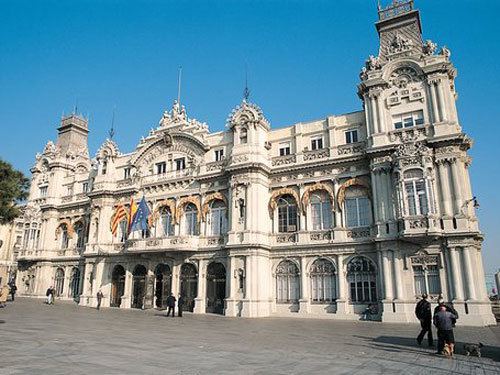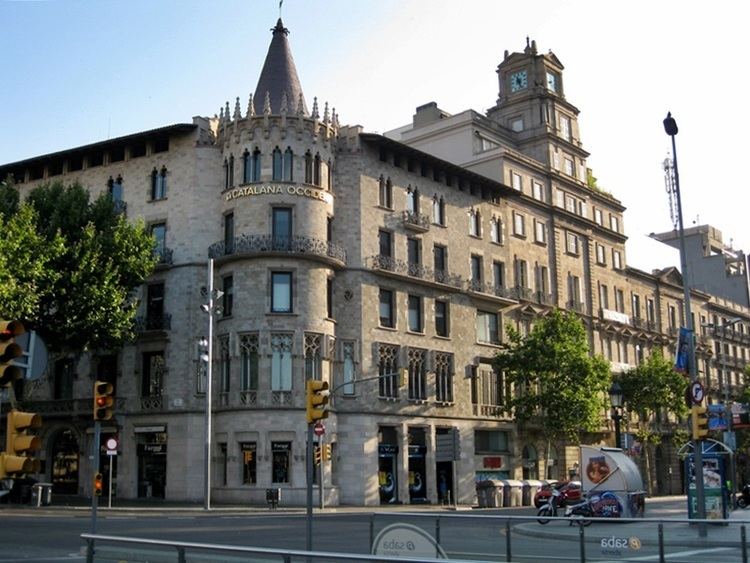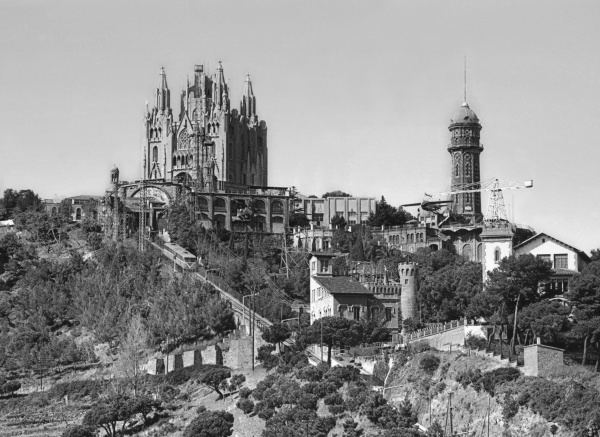Name Enric Sagnier Structures Sagrat Cor | Role Architect | |
 | ||
Died September 1, 1931, Barcelona, Spain | ||
Caixaforum barcelona enric sagnier la rotonda ciutat viva a lifeful city ciudad viva
Enric Sagnier i Villavecchia ([ənˈrik səŋniˈe]; Barcelona, 1858–1931) was a Catalan architect.
Contents
- Caixaforum barcelona enric sagnier la rotonda ciutat viva a lifeful city ciudad viva
- La Barcelona del arquitecto Sagnier
- Life and character
- Works
- Early works
- Modernista period
- Mature period
- References
Although now not as well known as his contemporaries Antoni Gaudi, Lluis Domenech i Montaner and Josep Puig i Cadafalch, he was responsible for a number of landmark buildings, was very prolific, and could turn his hand to many styles, including neo-Gothic, neo-Baroque and Modernista. He qualified as an architect in 1882, and one of his earliest works, together with Josep Domenech i Estapa, was the Palau de Justicia in Barcelona.

Other well-known buildings by him in Barcelona are the Caixa de Pensions building in the Via Laietana, the New Customs House (Duana) and the church on the Tibidabo.

La Barcelona del arquitecto Sagnier
Life and character

Enric Sagnier was born in Barcelona on 21 March 1858, the son of Lluis Sagnier i Nadal, president of the Caixa d’Estalvis i Mont de Pietat de Barcelona (a bank), and Clementina Villavecchia Busquets. His father was an outstanding Classics scholar, who translated Xenophon and Anacreon, and the young Enric was a talented painter and violinist. He studied at the Barcelona Higher School of Architecture, from which he graduated in 1882.

He began his professional career as an assistant to Francisco de Paula del Villar y Lozano: under his instructions he carried out his first work, the refurbishment of the chapel of Sant Josep in the church of Santa Maria de Montserrat abbey (1884). His first important work was the church of Santa Engracia de Montcada (1886), in neo-Gothic style; it was destroyed during the Spanish Civil War. His first apartment building, the Casa Cuyas, was built the same year.
He enjoyed considerable professional success from the beginning, receiving many commissions from the Church and the Catalan aristocracy. In 1886, while still in his twenties, he was commissioned, together with Josep Domenech i Estapa, to design Barcelona’s new Law Courts. Construction of this enormous project began the following year, and that same year Sagnier married Dolors Vidal-Ribas i Torrents. The couple had six children, of whom two died young and one, Josep Maria, also became an architect.
Enric Sagnier was a calm, devout man, who devoted his whole life to his career, and received many honours, such as the Barcelona City Council’s Gold Medal for having won a prize in the Council’s architecture competition three years running (1917). He was a member of the Academia de Belles Arts de Sant Jordi and the Cercle Artistic de Sant Lluc, a society of Catholic artists, for which he designed the emblem. He also became a member of the Museums Board and a member of the board of the Caixa d’Estalvis de Barcelona. He was occasionally involved in politics, serving as Provincial Deputy on two occasions, representing a Catholic group allied to the Lliga Regionalista, the Centre de Defensa Social. He maintained close links with the Church, particularly the Salesians; he was appointed Diocesan architect of Barcelona, and in 1923 the Pope created him a Marquis. In his later years he worked with his son Josep Maria Sagnier i Vidal. He died in Barcelona in 1931.
Works
Three things are characteristic of Sagnier’s work: he was very prolific; he was always ready to adopt new technologies; and he eschewed a rigidly personal style, preferring to adapt to changing tastes. His career can be divided into three periods: before 1900 his work was eclectic, monumental and grandiose; from 1900 to 1910 he turned to softer decorative forms in his architecture, adopting a Modernista style; and after 1910 he veered towards Neoclassicism, shunning the architectural trends of the moment.
Early works
As well as the new church of Montcada i Reixac and the Casa Cuyas already mentioned, Sagnier’s early works included a project for the Exposicion Universal de Barcelona (1888), which was never built; this was the Leo XIII pavilion, which was to have housed the representation of the Papal States.
During the last decade of the century, Sagnier devoted himself mainly to houses: Casa Juncadella, at Rambla Catalunya number 33 (1888–1891), notable for its ornamental sculpture and wrought iron; the Pons houses, at Passeig de Gracia 2 and 4 (1890), in neo-Gothic style, flanked by two pointed towers; the Tomas Roger house, at Ausias Marc 37-39 (1892–1894), combines Classical elements with sculptures alluding to the Plateresque style.
In the field of religious architecture, Sagnier received several commissions from the Salesians, such as the sanctuary of Santa Maria Auxiliadora (1889–1901), made up of a choir with room for 300 people and a three-aisled nave; for inspiration, Sagnier had turned to the mother house of the Salesians in Turin. Between 1892 and 1897 he designed the Jesus-Maria school, in Passeig de Sant Gervasi, neo-Gothic in style, and between 1892 and 1894, the college of the Sacred heart of Jesus, at the corner of Diputacio and Bailen, over a prior construction by Josep Vilaseca. In the Clot district he built the Centro de Nuestra Senora del Carmen y San Pedro Claver (1899–1903), a complex housing schools and training workshops for young workers, which was destroyed in 1936.
In 1893 he built the Fronton Barcelones, at Carrer Diputacio 415, the first facility in Barcelona for playing Basque pelota; it was open to the sky, and the spectators sat in a three-storey iron structure, decorated with stuccos; this building disappeared in 1902. Between 1896 and 1902, with Pere Garcia Faria, he built the New Customs House in the port of Barcelona, a typical example of his eclectic style.
Modernista period
At the turn of the 20th century, Sagnier drew closer to the Modernista forms that were then becoming the fashion, particularly in the use of the applied arts, the proliferation of sculpture and ironwork; however, the use of decorative stained glass, wall tiles and scratchwork, so characteristic of Modernisme, are much less evident in Sagnier’s work of this period.
One of the first of his works that could be described as Modernista was the Garriga house, at Diputacio 250 (1899–1901), with its elegant use of sculpture, landscapes in stained glass by A. Rigalt and the brackets that support the main balcony by Eusebi Arnau. The Juncadella house, at Rambla Catalunya 26 (1900–1901), includes many innovations by Sagnier such as trefoil openings, Baroque finials and the concentration of decoration in horizontal bands. The Carulla house, in Mallorca 214 (1900), was notable for its facade crowned by an allegory of painting, in Rococo style. In this period Sagnier also worked in the field of funerary architecture for the Catalan aristocracy, such as the hypogeum of the Olivella family (1909) or the Juncadella family tomb (1910), with its twin volumes flanking an obelisk.
In 1903 Sagnier became architect to the Benedictine abbey of Montserrat, taking over from his former mentor Villar y Lozano. He was responsible for a number of works there, all of which have now disappeared: the chapel of the Most Holy Sacrament; a sumptuous marble altar with gilded metalwork; the Second Mystery of the Rosary, with a sculptural group by Agapit Vallmitjana i Abarca; and the sculptural group of the Stations of the Cross (1904–16), on the hillside of Montserrat, with sculptures by Eusebi Arnau, made up of fourteen Stations in a vaguely Gaudiesque style: roughly hewn surfaces, naturalistic pinnacles, etc. It was perhaps because of this link with the Benedictine order that he received a commission to design a school in Perth (Australia), where there was a mission, New Norcia, under the aegis of a Catalan abbot, Fulgenci Torres Mayans; there he was responsible for the church and Saint Gertrude school (1904–1906), in neo-Gothic style.
Also from this period, although not at all Modernista in style, is what is undoubtedly Sagnier's most important religious work, the Templo Expiatorio del Sagrado Corazon, on the Tibidabo in Barcelona, work on which began in 1902 and went on until 1961, continued after Enric Sagnier’s death by his son Josep Maria. This work was fruit of the patronage of Dorotea de Chopitea, who along with other promoters donated land to Saint John Bosco during his visit to Barcelona in 1886, for the construction of a church dedicated to the Sacred Heart of Jesus, after the one built in Rome by Bosco himself (Sacro Cuore di Gesu), as well as the famous Sacre-Cœur in Paris. The foundation stone was laid on 28 December 1902 in a ceremony led by the bishop of Barcelona, Salvador Casanas i Pages.
The basilica is made up of a crypt below and the upper church, with a central dome supported on eight columns. The crypt, with a Byzantine air, was built between 1902 and 1911, and the upper church between 1915 and 1951, although the exterior was not finished until 1961. The neo-Romanesque style of the crypt culminates in the Gothic verticals of the upper church, topped by the image of the Sacred Heart. The original statue was by Frederic Mares, but this was destroyed in 1936 and replaced with the existing one by Josep Miret in 1950. The exterior of the church is more stylistically contained than is the case of the flamboyant Gothic of Sagnier’s early projects.
Another of Sagnier’s works on the Tibidabo from this period is the mansion for the banker Manuel Arnus (1902), which occupies a highly prominent site on a spur of the hillside and is visible from many parts of the city. Sagnier used Montjuic stone as well as scratchwork and tiles; the carved stone decoration is naturalist in style, similar to that used in the nearby church of the Sagrat Cor. The towers and trefoil openings give it a mediaeval air, while the gallery is reminiscent of the traditional Catalan farmhouse, the masia.
Other works from this period are the Mulleras house, at Gran Via 654 (1903–1905), in neo-Rococo style, and "La Pompeia", a church and monastery for the Capuchin order (1907–1915) at Diagonal, 450, so called because it is dedicated to Our Lady of the Rosary of Pompeii. It draws inspiration from Catalan Gothic architecture in features such as the roof of the church, made up of beams supported on diaphragm arches, similar to those of the Santa Agata chapel in the mediaeval royal palace in the Gothic Quarter, and the style of the tower in the west end, reminiscent of those of Santa Maria del Mar.
Mature period
In the following years, Sagnier entered a period of less intense professional activity, and received ample official recognition. He gradually abandoned Modernisme, adopting a personal, eclectic Classical style. In 1911 he won the competition to design the Real Club Maritimo in Barcelona (built between 1911 and 1913), an octagonal building roofed by a dome and topped by a sort of lighthouse; it was demolished in 1957. In 1912 he began to build the French Chapel in Carrer Bruc, with a crypt divided into three aisles and an upper church in neo-Romanesque style, finished in 1927 probably by his son Josep Maria. Also in 1912 he built the palatial residence of the marquis of Alella, on the corner of the streets of Muntaner and Maria Cubi, a group of buildings in a style influenced by Plateresque, with paintings by Josep Maria Sert.
Between 1916 and 1936 Sagnier designed a complex of buildings for the Provincial Board for the Protection of Children and Suppression of Begging, which were completed by Josep Maria Sagnier. These occupied a whole city block in the Bogatell district, an ambitious facility divided into pavilions with a frontage on several streets, with courtyards in the centre. Most of the complex was demolished in 1970, leaving only the pavilion currently used to house the Wad-Ras prison.
Perhaps Sagnier’s most important work from this period is the headquarters building for the Caixa de Pensions de Barcelona savings bank, in Via Laietana (1914–1917). As originally conceived there were to be offices on the ground floor and apartments for rent on the upper floors, in order to generate income from the investment. The main facade, dominated by the tower and giving onto the corner of Via Laietana and what was then the Placa de Bilbao, has the principal entrance doors on the ground floor, and above them the grand windows of the boardroom and the senior management offices, while entry to the rental apartments was from the frontages on the side-streets. The structure of the building employs reinforced concrete—a pioneering material at the time—with an external stone cladding. The original banking hall was richly decorated with paintings and marbles and was lit from above by a skylight.
The Caixa soon outgrew these premises, and in 1920 they commissioned Sagnier to build an annex around the corner in Carrer Jonqueres. He was also responsible for several branch offices for the Caixa, in Igualada (1922), Sabadell (1923), Manresa (1924) and Tarragona (1929).
During the First World War, boom years in Spain as a result of its neutrality, Sagnier received many commissions: between 1915 and 1926 he executed the basilica of Sant Josep Oriol, in Carrer Diputacio. Stylistically, this church breaks with the contemporary fashion for Mediaevalism—neo-Gothic and neo-Romanesque—adopting instead the form of a Roman basilica with aisles separated by arcades, a pattern subsequently often used in the post-Civil War period. In 1915 he designed a project to lay out the Miramar area of Montjuic, but in the end it was not used. In this time he also received two commissions for buildings in the Placa de Catalunya: the reconstruction of the Hotel Colon (1916), which no longer exists, but in which he replaced the earlier Modernista building with one of Classical style; and the Banca Arnus building (1918–1927), now the Banco Central Hispanoamericano, also in a Classical style.
From about 1920, Sagnier worked less: notable amongst his late works is the Patronato Ribas, an orphanage in Vall d’Hebron 93-103 (1920–1930); it is an ingeniously structured complex of buildings, arranged symmetrically round the axis of the chapel in H-shaped blocks; the decoration harks back to Baroque populism, notably the terracota reliefs inspired in Catalan tradition. The buildings now house a secondary school (IES Vall d’Hebron).
Sagnier was a member of the jury to decide on projects for the 1929 Barcelona International Exposition on Montjuic, amongst others, the competition for the design of the Central Palace of the Expo—now Palau Nacional and home to the Museu Nacional d'Art de Catalunya. As part of the run-up to the Expo, Sagnier was commissioned to restore the Archbishop’s Palace in Barcelona; the work consisted of modifying the interior courtyard, revealing an original Gothic window and Romanesque arcades, and constructing a new staircase. As diocesan architect, he was also asked, in conjunction with Bonaventura Bassegoda, to move the choir stalls of Barcelona cathedral, but this project was never carried out. Being a member of the Provincial Council he also designed the Spanish Provinces pavilion for the 1929 Expo, in Plateresque Gothic style, with an equestrian statue of Saint George by Josep Llimona. Also, at the Ibero-American Exposition of 1929 in Seville he built the pavilion for the Catalan provinces, a building in the shape of the traditional Catalan farmhouse, the masia.
